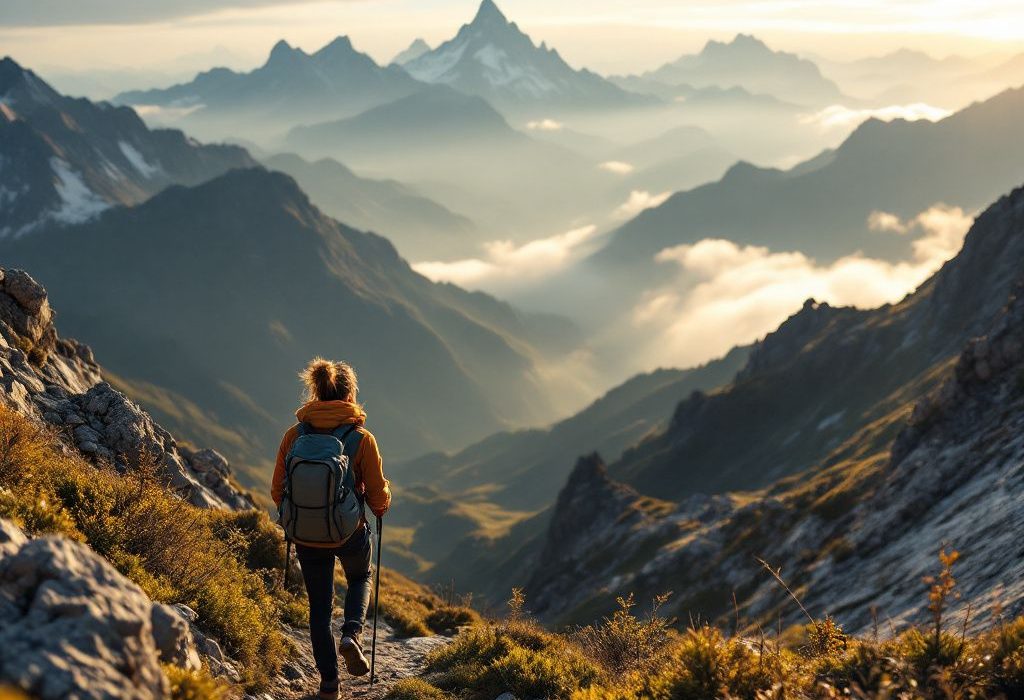Hey there, adventure seekers and nature lovers! Have you ever come back from an exhilarating mountain trip only to catch a glimpse of your reflection, puzzled by how your skin matured faster than the duration of your trip? You’re not alone. This scenario paints a familiar picture for many travelers and outdoor enthusiasts. Let’s dive into this conversation: Why does a loving mountain escape sometimes leave us with a less-than-enthusiastic hello from our skin? The link between altitude and skin aging is undeniably fascinating. It’s all about that rarefied air and a great deal of UV exposure. Stick with me, and we’ll unravel how altitude skincare can help you look fresher than that mountain air during future treks. If you’re curious about integrating retinol into your routine even in your 20s, it’s a journey worth exploring to maintain youthful skin amidst the elements.
The Mountain’s Whisper: Elevated Skin Challenges
Picture this: you’re snapping photos of jagged peaks over a crisp, blue sky, feeling quite literally on top of the world. But while you’re basking in your picturesque moment, those same peaks whisper a little secret—higher altitudes bring sneaky skincare challenges.
UV Radiation: The Stealthy Culprit
Here it is, the first trickster at high altitudes—UV radiation. With every ascent, you venture closer to the sun. Simple physics! For every 1000 meters (or about 3280 feet, give or take), UV radiation levels can increase by up to 12%. Steeper slopes equal steeper exposure, like chilling out under a giant magnifying glass.
UV radiation accelerates skin aging in so many ways you’d lose count. It breaks down collagen, the main building block of youthful-looking skin, and escalates the formation of fine lines and wrinkles. So when you’re enduring panoramic beauty, your skin may pay a clandestine toll.
Thinner Air, Thicker Problems

Let’s not forget the moisture that evaporates faster up there. Yep, it’s drier than that favorite bottle of wine you forgot to screw the cap back on. With each ‘hardcore hiker’ breath you take, the air’s low humidity works double-time to dehydrate your skin. Dry air isn’t just uncomfortable; it signals your skin to crank up oil production, which can clog pores. So while you’re reveling in that minty fresh altitude, your skin might be plotting its vendetta. To counteract these effects, incorporating natural night creams can be a game-changer for overnight skin recovery.
Altitude Skincare: An SOS From the Skin
Alright, you know the drill: problem, meet solution. The buzz isn’t just about high altitude woes; it’s about altitude skincare fueling our mountain-loving spirit. Here’s how to wage a winning war against the elements up there.
Hydration: The Unsung Hero
Where’s your water bottle? No, seriously, go drink some water right now! Hydration is a loyal sidekick when confronting altitude. Drink like you’re savoring the refreshing glacier you viewed earlier. Dehydrated skin is notorious for showing fine lines quicker than a fast-forward feed. Moisturizing—time to let those creams and serums join the uphill trek. Look out for moisturizers containing ingredients like hyaluronic acid, glycerin, or ceramides to lock in the moisture. This is where understanding the ultimate role of ceramides in skincare becomes crucial for maintaining skin barrier function.
Sunscreen: Your Trusty Shield
Consider your sunscreen application a non-negotiable mountain ritual. Trust me on this one. You need a broad-spectral sunscreen, meaning it fights off both UVB (those little devils causing sunburn) and UVA rays (the wrinkles we’ve mentioned), boasting an SPF of at least 30. Reapply throughout your sunny pow-wow as if it’s the key to an honorable skin-do no matter your altitude. You might also find it beneficial to explore a minimalist skincare approach to streamline your routine without sacrificing protection.
The Accessory Essentials

Throw in fashion bonuses that double as skin saviors. Sunglasses are the definition of chic—plus they kick crow’s feet prevention into high gear. Wide-brimmed hats provide portable shade even a cedar grove envies. Covering up not only reduces UV exposure but throws in extra comfort, too. For those who love to experiment, beginner-friendly skincare innovations can also offer fresh ways of protecting and nurturing your skin against the harsh elements.
Breathe Easy: Adapt and Thrive
An altitude adventure doesn’t just demand gears and guts. Your skin, equally vulnerable, fits neatly on that list.
Take Care of Your Respiration
Give your skin its fair share of oxygen. Yes, golden essence carries skin-reviving coals. With decreased oxygen availability at high altitudes, your cells fight harder to consume it—triggering oxidative stress, another factor sending your skin into aging hyperdrive. Breathe slowly and deeply to maximize this precious cargo. Pairing this with a diet that supports skin health can further optimize your skin’s resilience against the stresses of high altitudes.
Nutrient Knowledge: Fuel From Within
Ah, the magic combo: diet and skin. They hold hands more than you might think. A mountain diet rich in antioxidants can work wonders. Foods overflowing with antioxidants counteract the altitude’s effects by neutralizing pesky free radicals. So crinkle up some carrots or drop almonds into your satchel. Additionally, exploring homemade natural skincare options can complement a nutrient-rich diet to nourish your skin from the inside out.
Lessons from Oceans Above: An Experience for the Earth

Trailblazing through lush alpine paths lays bare another privilege—the sight of paradise that might disappear without everyone’s husbandry. So here’s a little nudge. While we explore and employ altitude-friendly protection methods, remember to carry those lessons home, too. Part of this journey involves understanding the ultimate cream in skincare that aligns with both environmental consciousness and skin needs.
Environmentally Responsible SPF
Several sunscreens damage fragile mountain ecosystems, particularly aquatic life. Choose biodegradable or reef-safe sunscreens, reducing your carbon footprint as ardently as your UV makeover guards your skin. Same altitude care—same planet respect: what we leave in paradise shouldn’t be left to chance.
Leave No Trace
Within the folds of your sunscreen should fit the ethos of minimal disruption. Just like our skincare essentials adapt wisely, so should our attitudes. Haul out what you haul in, even your biodegradable attitudes. Alpine terrains tell stories older than any of us, worth keeping unscarred.
Picture-Perfect Conclusion
There you are, lovely wanderers, proud to crack the code between high altitude enchantment and skin aging predictions! The effects of altitude on skin needn’t be folklore or grudging acceptance. Knowledge, after all, navigates formidable peaks and reshapes them to our advantage.
Whether locking your routine in front of views that defy gravity or crafting altitude-oriented habits under clouded skies a bit lower, there’s comfort in solutions we’ve shared. And hey, remember—I’ll be up here too, chasing that freshness amid jagged beauty, thriving right alongside you. Happy trails and graceful aging to us all.
Frequently Asked Questions
How does high altitude affect the skin?
High altitude affects the skin in several ways, including lower air pressure, reduced humidity, intense UV radiation, extreme temperatures, and strong winds. These conditions can lead to dry, dehydrated skin, sun damage, windburn, and increased risk of premature aging and skin cancer[1][3][4).
What skincare products are best for high-altitude environments?
For high-altitude environments, it is best to use skincare products that provide intense hydration, protect against UV radiation, and combat oxidative stress. Products containing hyaluronic acid, glycerin, and antioxidants such as vitamin C and green tea are highly recommended. Additionally, using rich moisturizers, broad-spectrum sunscreens with at least SPF 30, and hydrating masks can help maintain skin health[1][3][5).
What lifestyle changes can help protect the skin at high altitudes?
To protect the skin at high altitudes, it is crucial to stay hydrated by drinking plenty of water, wear protective clothing and sunscreen daily, use humidifiers to combat dry indoor air, and opt for lukewarm showers to preserve skin oils. A diet rich in antioxidants, omega-3 fatty acids, and hydrating foods also supports skin health[1][2][3).
How often should I moisturize my skin at high altitudes?
At high altitudes, it is essential to moisturize your skin frequently due to the dry air. Using a lightweight moisturizer during the day and a richer moisturizer at night can help maintain skin hydration. Additionally, applying moisturizer immediately after bathing or showering can help lock in moisture[2][3][4).
References

